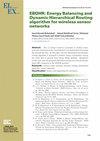一种采用65纳米CMOS的ku波段发射机前端,具有45 dbc的图像抑制比和43 dbc的LOFT抑制
IF 0.7
4区 工程技术
Q4 ENGINEERING, ELECTRICAL & ELECTRONIC
引用次数: 0
摘要
本文提出了一种完全集成的ku波段发射机前端,具有高图像抑制比(IRR)、本振馈通(LOFT)抑制、增益和输出功率,适用于点对点(P2P)通信。为了避免片外图像抑制滤波器体积庞大,采用Hartley发射机结构,采用频率计划提高IRR和LOFT性能,并采用两级多相滤波器(PPF)和I/Q吉尔伯特混频器进一步提高IRR。利用电容中和和基于变压器的串联功率组合技术,利用两级功率放大器获得高增益和输出功率。在本振缓冲器中,采用柔性反相级联码结构实现可靠的上带工作,并采用感应峰值技术和交叉耦合晶体管对提高本振摆幅。该ku波段发射机采用65纳米CMOS工艺制造,芯片面积为0.98 mm2,在1.2 v电源电压下功耗为304 mw。通过测量,在15.8-17.9 ghz的射频(RF)带宽范围内,发射机的IRR和LOFT抑制比分别达到45-55 dBc和43-52 dBc。此外,它的转换增益为28.5 dB,输出1-dB压缩点(OP1dB)为13.3 dBm,饱和输出功率(Psat)为16 dBm。本文章由计算机程序翻译,如有差异,请以英文原文为准。
A Ku-band transmitter front-end in 65-nm CMOS with >45-dBc image-rejection ratio and >43-dBc LOFT suppression
This paper presents a fully integrated Ku-band transmitter front-end with high image rejection ratio (IRR), local oscillator feedthrough (LOFT) suppression, gain and output power for point-to-point (P2P) communication. To avoid the bulky off-chip image-rejection filter, the Hartley transmitter structure is employed, in which frequency plan is undertaken to improve the IRR and LOFT performance, and a two-stage polyphase filter (PPF) and an in/quadrature-phase (I/Q) Gilbert mixer are utilized to improve the IRR further. With the capacitive neutralization and transformer-based series power combining techniques, a two-stage power amplifier (PA) is used to obtain high gain and output power. In the LO buffer, a flexible phase inverting cascode structure is used to achieve reliable up-sideband operation, and the inductive peaking technique and cross-coupled transistor pair are employed to promote the LO swing. Fabricated in a 65-nm CMOS process, the proposed Ku-band transmitter occupies a chip area of 0.98 mm2, and consumes 304-mW power consumption from a 1.2-V supply voltage. With measurements, over 15.8-17.9-GHz radio frequency (RF) bandwidth, the transmitter achieves an IRR and LOFT suppression ratio of 45-55 and 43-52 dBc, respectively. Moreover, it exhibits a conversion gain of 28.5 dB, an output 1-dB compression point (OP1dB) of 13.3 dBm and a saturated output power (Psat) of 16 dBm.
求助全文
通过发布文献求助,成功后即可免费获取论文全文。
去求助
来源期刊

Ieice Electronics Express
工程技术-工程:电子与电气
CiteScore
1.50
自引率
37.50%
发文量
119
审稿时长
1.1 months
期刊介绍:
An aim of ELEX is rapid publication of original, peer-reviewed short papers that treat the field of modern electronics and electrical engineering. The boundaries of acceptable fields are not strictly delimited and they are flexibly varied to reflect trends of the fields. The scope of ELEX has mainly been focused on device and circuit technologies. Current appropriate topics include:
- Integrated optoelectronics (lasers and optoelectronic devices, silicon photonics, planar lightwave circuits, polymer optical circuits, etc.)
- Optical hardware (fiber optics, microwave photonics, optical interconnects, photonic signal processing, photonic integration and modules, optical sensing, etc.)
- Electromagnetic theory
- Microwave and millimeter-wave devices, circuits, and modules
- THz devices, circuits and modules
- Electron devices, circuits and modules (silicon, compound semiconductor, organic and novel materials)
- Integrated circuits (memory, logic, analog, RF, sensor)
- Power devices and circuits
- Micro- or nano-electromechanical systems
- Circuits and modules for storage
- Superconducting electronics
- Energy harvesting devices, circuits and modules
- Circuits and modules for electronic displays
- Circuits and modules for electronic instrumentation
- Devices, circuits and modules for IoT and biomedical applications
 求助内容:
求助内容: 应助结果提醒方式:
应助结果提醒方式:


